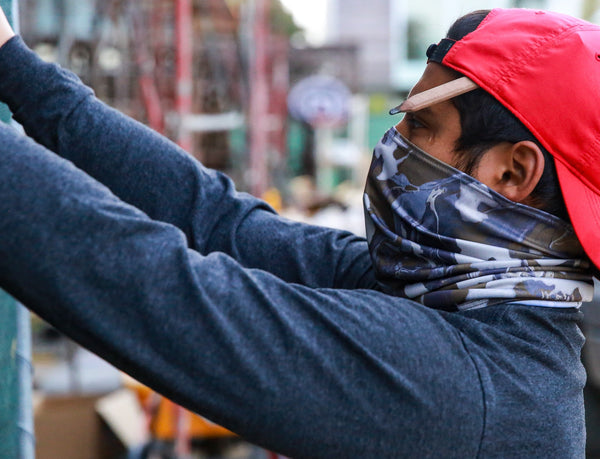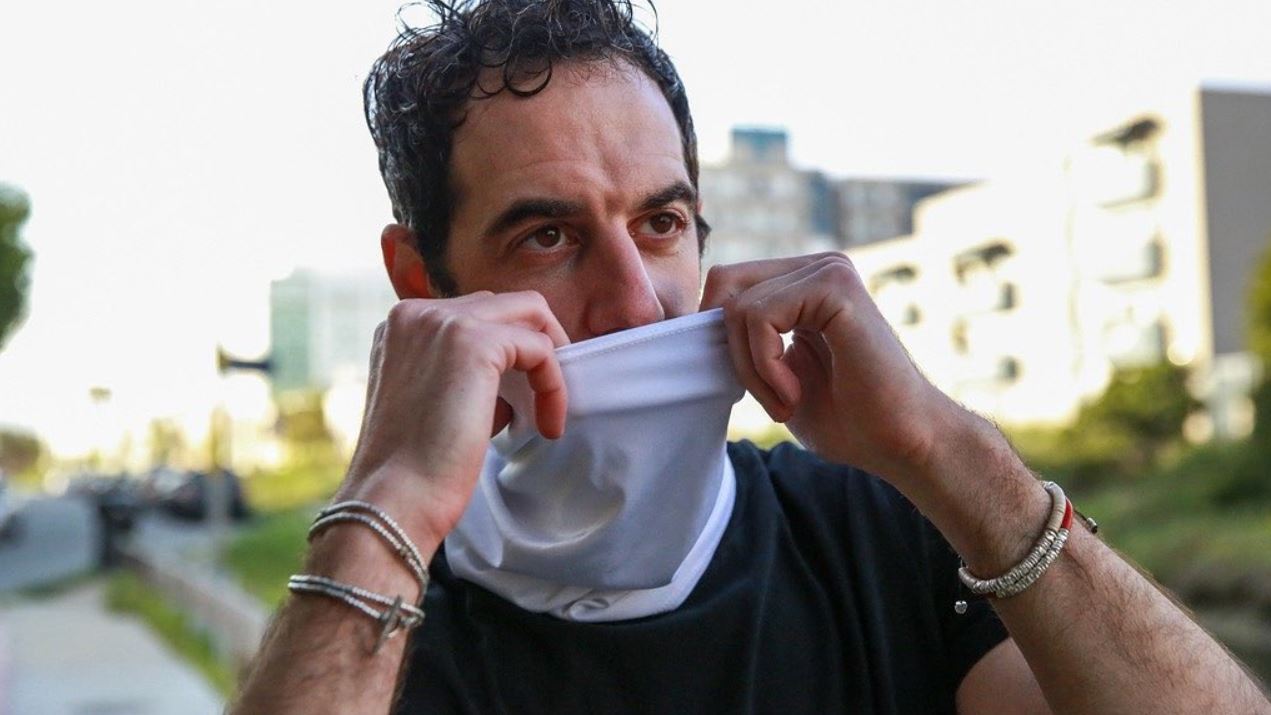Each Dotted Line Manufacturing neck gaiter and face mask isn't only durable and antimicrobrial — they're also moisture-wicking! Have you heard this phrase before and wondered what it meant? Then this article's for you. Let's delve into all the essential info you should know about moisture-wicking fabric.
"Moisture-Wicking" — What Does It Actually Mean?
Moisture-wicking fabrics take care of two tasks:
- They rapidly move sweat to the outer surface of the fabric.
- They dry quickly so your fabric doesn't get saturated by sweat.
As a result of these two key actions, your fabric never gets that nasty soggy, sticky feeling.Pretty cool, right? Whether it's a neck gaiter, jacket, shirt, or pants, wearing moisture-wicking clothing makes physical activity much more comfortable because it allows your body to regulate temperature better.
So, How Does Moisture-Wicking Really Work?
A fabric's moisture-wicking performance depends on two main factors: capillary action and permeability.
Capillary action is the movement of liquid (e.g., sweat, rain, etc.) through small spaces within the fabric due to molecular forces between the fabric's internal surfaces and the liquid. Permeability refers to a fabric's capability to transfer moisture through its layers; this is determined by the sizes of spaces within the fabric and the connections between them.
Through structural engineering of the yarns and application of chemical treatments to their surfaces,fabric makers can improve both the capillary action and permeability. But there's no need to sweat the science. Just look for the phrase "moisture-wicking" on the items that you're thinking of buying. Also don't bother getting hung up on any testing claims; there's no standard test for comparison. That means brands can use whatever analyses they choose to measure how well their fabric wicks away moisture.
Why Wear Moisture-Wicking Clothing?
Are you often outdoors or engaged in physical activity that causes your heart rate to rise? Then you're probably sweating to some degree. When you sweat, it evaporates and creates a cooling effect. You usually stop sweating once your body cools to a comfortable temperature.

If you're wearing normal fabrics, you'll be left with soggy, uncomfortable clothing. On the other hand, moisture-wicking fabrics help keep your skin dry and cool.
When to Wear Moisture-Wicking Clothing?
Generally, you want to wear moisture-wicking fabric for any clothing layer that comes into contact with your skin. You especially want to wear it when participating in aerobic, strenuous (i.e., sweat-producing) activities such as hiking, biking, running, yoga, and even walking.
The Best Best Moisture-Wicking Fabrics
If a fabric's yarns absorb moisture instead of moving it through its spaces, that moisture will stay trapped there. This is the opposite of what you want. Instead, you should aim for fabrics that provide resistance to moisture penetration.
Synthetics
Polyester, nylon, and other synthetic fabrics are popular choices for moisture-wicking clothing. Because they resist the penetration of water, they excel at moisture-wicking. Not only are synthetic materials inexpensive and easy to dry while in use, but they also offer great breathability and are usually durable and long-lasting.

Synthetic materials can come with a few disadvantages, though. Some clothing using these fabrics don't retain heat efficiently in cold temperatures, and they may not be as odor-resistant as other fabrics. Still, the pros typically far outweigh the cons, which is why you see tons of outdoor brands utilizing synthetic fabrics in their clothing.
Wool
Wool is another fabric that wicks away moisture. But it differs from synthetic fabrics in that it actually does absorb a small amount of moisture into the core of its fibers. But it still allows moisture to escape through the fabric's small openings. The result? Wool surfaces stay dry to the touch.
Plenty of wool clothing can keep your skin dry while offering good breathability and some resistance to odors. But it's quite costly. To make matters worse, wool usually doesn't last as long as other fabrics.
Fabrics to Avoid
If you're looking for moisture-wicking clothing, avoid cotton. Essentially, this is an anti-moisture-wicking fabric. Cotton gets completely saturated with sweat. To make matters worse, it takes a long time to dry.
If you're doing physical activity, cotton will initially make you feel overheated and sweaty. Once your body cools down, you'll feel cold and clammy. Cotton's anti-moisture-wicking properties are well known. That's why a ton of clothing makers specially treat their cotton offerings with moisture-wicking chemicals. Still, their performance is far behind synthetics and wool.
How to Take Care of Moisture-Wicking Clothing
When washing moisture-wicking garments, avoid using fabric softener at all costs. Whether it's in the liquid or dryer-sheet form, fabric softeners release a waxy residue that interferes with a fabric's surface. Basically, if you use fabric softener, you'll get a softer feel — at the expense of moisture-wicking performance.

We hope you enjoyed this brief overview of what moisture-wicking is and why it matters so much when you're doing physical or outdoor activities. This fabric property may seem subtle, but it can make a big difference in the comfort and enjoyment of your experiences.
Want to distribute neck gaiters and face masks that wick moisture away effectively? Learn more here!

